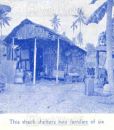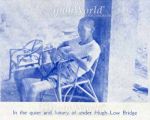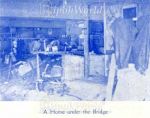We've tried to ensure the information displayed here is as accurate as possible. Should there be any inaccuracies, we would be grateful if you could let us know at info@ipohworld.org . All images and content are copyright.
(Please click on the thumbnail for a bigger image.)
An Article From The Michaelian - The Slums Of Ipoh





There is a Russian proverb which says “Every country has the Jews it deserves”. Perhaps I may be allowed to parody it into “Every town has the slums it deserves”, and that, I suppose, goes for Ipoh too. I am not lacking in loyalty to my home town in saying so. I am only trying to prove that Ipoh is a normal town, and not just an Eldorado in the creative imagination of some artist or an ideal town in the dreams of a town planning expert.
In this article I wish to give a glimpse of our slums and the life of their dwellers. I will begin with Kampong Pisang since it is nearest to our school. Every one knows that “pisang” means banana, hence Kampong Pisang means no more than “banana village”. There are still odd plants of that delectable species here and there in the area, but to say that it is a “banana village” is now sheer exaggeration. It is not a typical city slum in that sense that it is a part of the town where the poor crowd together. In fact it is part of the countryside with groves of trees - a haven of shade and quiet. The fact that most of the houses there, built to house a family of three or four, have now as many families in each may justify the name slum. Though the inhabitants are predominantly Malay, there are many Chinese living there in evident friendship with their Malay neighbours.
Standing on a bank of the Kinta River, Kampong Pisang has a great future because Ipoh is expanding by leaps and bounds. Very soon modern houses will replace the “pondoks” and other apologies of human habitation. But this is small comfort to the inhabitants for they will not become the owners or even tenants of those modern houses to be built there. They will be driven farther from the town and be obliged to continue their bleak existence under severer conditions. The occupations of the inhabitants vary - some are office-workers while others are employed in the different commercial firms or industrial concerns of the town.
There is another kampong slum - that behind the Borneo Motors, and it is called Kampong Java, possibly because the early inhabitants were mostly Javanese. Most of the houses in this kampong are of wooden structure with attap roofing. That it must have been a rubber estate in its earlier days is shown by the number of rubber trees all over the place. When the price of rubber was good, the trees were regularly tapped, but now they are left alone. The inhabitants there are predominantly Chinese and strange to say that some of them are evidently well-to-do because they own beautiful cars. The majority of them come to the town to work.
The author in the course of his tour of the slum areas happened to visit the bridge-dwellers of Ipoh. They are a strange lot of people living under the two bridges across the Kinta River, namely the Hugh Low Street bridge and the Brewster Road bridge. All in all they are one hundred strong. They are not beggars. God help them that call them so. The places are swept scrupulously clean and they make and they make good use of nature’s conservancy system - the river. The place is airy and cool as breezes continually blow up from the river. In fact, if the authorities allow, comfortable compartments may be easily built with the bridge serving as roof and ceiling. The inhabitants there are all Chinese and their ages range from thirty to eighty=five. Many of them had seen better days. One was a miner who had come with several others from China. Some of his friends had succeeded in life and are comfortably housed but this one had been less fortunate. Another had seen New York and London. When I asked him how he was so much travelled, back came the answer “I was a sailor on board a Chinese ship”. A third had been a rubber tapper and was now too old for work. The reader may ask, “But how do these people make a living?” Well, some are trishaw-pedalers while the older ones are scavengers. The authorities, I was told, tried to resettle them but could not find a suitable place for them. These bridge-dwellers of Ipoh are very interesting people and pleasant to meet. I was touched by their polished manners and responsiveness.
Now come with me to Kampong Kuchai. As you approach the Majestic Theatre from Hugh Low Street, you turn right and a few chains away you will see a hive of engineering activity. Motor repairers, spray painters, coach-builders, tinkers, welders, turners, black-smiths, and what not - all connected with the motor repairing industry = keep shop. Explore this area and you will see the most interesting slums in Ipoh. Here live the workers that staff the different branches of the motor repairing trade I have mentioned. You find too hawkers of every description or suppliers of wares to the hawking trade - cakes, koay-teow, meat balls, bean curd are some of the popular eatables produced here for the Ipoh market, in many cases, under conditions far from desirable. Artisans, including carpenters, painters, bamboo-weavers and also a piano-tuner, live here.
Let me take you into a typical house with a floor space of about 1200 square feet. It houses four families, doing cooking in the premises and two which do no cooking. Each room shelters a family of from two to five or six members. There are no bedsteads in most rooms. Raised wooden floors serve as beds where all huddle together for the night’s repose. Two families share a kitchen. For each of the other two, a piece of iron roofing outside, supported on four posts, serves as a kitchen which is unusable an bad weather.
There are other “kampongs” around Ipoh of the same pattern as those already mentioned with ramshackle dwellings, bad drainage, overpopulation and general poverty. Water is either taken out from wells or carried in tins from the public stand-pipes. There is no public lighting. Most of the households depend on oil lamps for light. Some of the houses are owned by the occupiers, but most of them are let out to tenants at rents in some cases higher than those paid for better built rooms in the town. The reason given to me is that there is more space for the children to run about in the kampong than in the town and more safety.
The slums in Ipoh town are to be found in the lanes and side-streets. In the Old Town, we have Market Lane and Panglima Lane. The houses of these lanes abut on to those of the main streets and the refuse and night soil have to be carried out through the main door. The “China Town” of Ipoh is in the New Town, in the Cowan Street ends of Theatre Street and Yau Tet Shin Street. If you wish to see washings hung out in the Singapore fashion, you can see them here but over the back lanes.
Much has been said elsewhere that the slums are haunts of immorality and juvenile delinquency. A casual observer like me cannot penetrate too deeply into the private life of the people in the slums he visits and is therefore not in a position to say very much. But what surprises me is not the vice but the peaceful, industrious and law-abiding habits of the people. As a rule they are not hostile to or are suspicious of new faces but enter readily into conversation if you speak to them courteously and amicably. The younger children are generally dirty and ill-clad but the older ones seem to have come under the refining influence of schools. In fact almost all the children of school-going age are school boys or girls.
Slum clearance is the cry of most cities nowadays. It is important that our Fathers should study the problem of our slums and provide that the poorest inhabitants of our home town may have comfortable homes.
School Certificate B
The photographs included with this article are shown above. The captions from left to right read:
To read more about Brewster Road Bridge (Previously Known as Birch Bridge), click here.
To read more about Hugh Low Bridge, click here.
To read more about Panglima Lane, click here.
To read more about Ipoh’s Trishaws, click here.
To read more about Ipoh’s Street Names, click here.